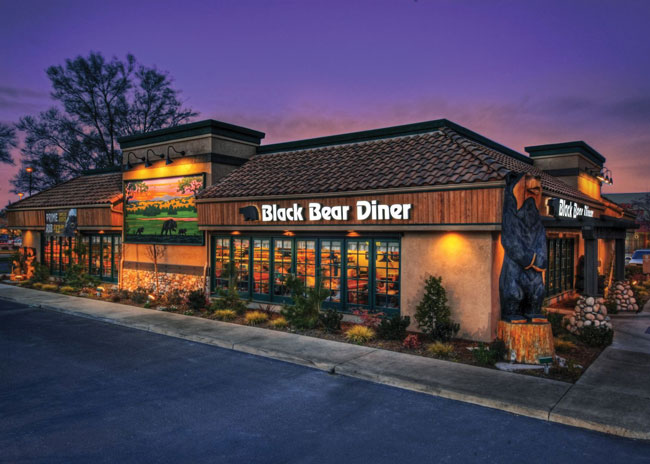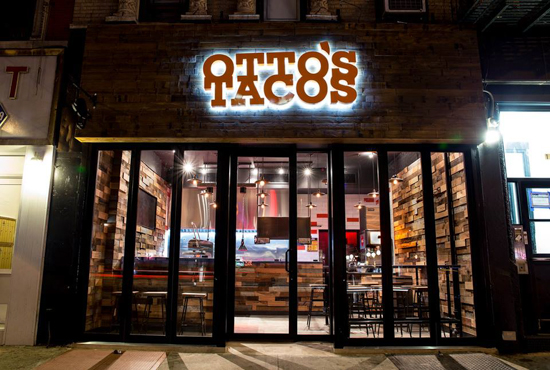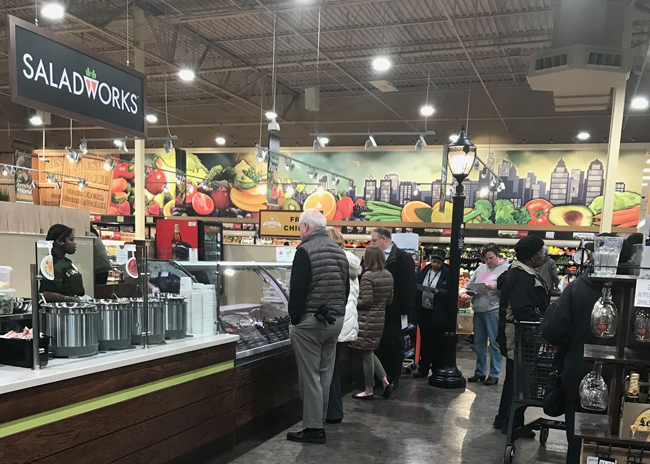The extraordinary events of 2020 have spelled turmoil, upheaval, retrenchment and, in many cases, surrender for much of the restaurant industry. Sales, employment and capital investment levels have plummeted faster and farther than at any time in history, and for many brands, simply surviving 2020 trumps any thoughts of development and growth. But for a relative few — those whose concepts and operational models fit the times, whose financial positions enable investment in new systems and new opportunities — development and growth are, indeed, still happening. New prototype designs are debuting, new franchisees are signing deals and existing franchisees are adding units, turning current market conditions to their advantage. In a few cases, after startling declines during the early days of the pandemic, new sales records are now being set. Here are a few stories from the front with insights from brand leaders on why they’re optimistic.
Images courtesy of their respective brands.
Zaxby’s
 Recovery Strategies Pay Off
Recovery Strategies Pay Off
“We’re anticipating total development of 20 stores for 2020, including new locations and store relocations and rebuilds,” says Amy Pritchett, vice president of Franchise Development at Athens, Ga.-based Zaxby’s. “Development will likely increase significantly moving into 2021 with both remodels and new store development.”
The fast-casual chicken brand credits its success during the pandemic to several key strategic moves. A quick pivot to drive-thru, delivery and curbside pickup was critical, Pritchett notes. She adds that the chain is now working to develop a new building prototype focused on off-premises sales.
Zaxby’s also waived $5 million in fees for licensees and added affordable, family-friendly meals to its menus as part of its COVID-19 recovery strategy. The company says its proactive initiatives enabled it to recover faster than many of its peers, posting some of its best year-over-year comp sales in company history in early to mid-May, despite most dining rooms still being closed.
As for new locations, Zaxby’s opened in West Palm Beach, Fla., on June 8, bringing the brand to 905 units over 17 states. That’s one of several units opened since May, including two units in Georgia and one each in South Carolina and Tennessee.
“Current expansion is coming primarily from our existing licensees,” Pritchett notes. “There are 300 stores in the development pipeline, and we have agreements in place with licensees to further develop markets over several years. We’re seeing more and more motivation from existing franchisees to start their next location. They’re encouraged by the brand’s performance during the crisis and are more committed now than ever.”
Juice It Up!
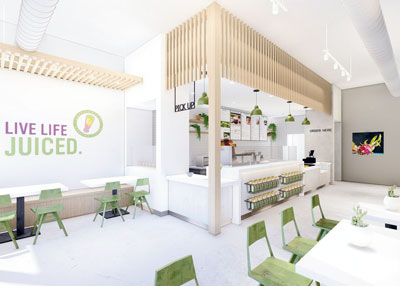 Boosting Downturn Immunity
Boosting Downturn Immunity
Sales took a hit at Irvine, Calif.-based Juice It Up! during the first few weeks of the COVID-19 crisis, but momentum quickly picked up, even sending comp sales above those of the prior year, according to President and CEO Chris Braun. “It’s been a remarkable turnaround compared to the beginning of COVID-19,” he notes. “We’ve been able to adapt and are one of the fortunate ones that have been able to grow through all that’s going on now.”
Braun credits the rebound to guest loyalty and marketing efforts designed to enhance brand positioning around Juice It Up!’s healthful smoothies, raw juices and superfruit bowls, many with immune-boosting ingredients. He also credits franchisees’ ability to adapt to 100% off-premises sales models, including incorporating curbside pickup and expanding third-party delivery, already in place at many units, systemwide.
While still down from the 80-plus-unit brand’s preferred target of 10% unit growth per year, development is ramping back up, with existing franchisees eager to add more stores and discussions underway with several new area developers, according to Braun. He notes that existing California markets will continue to be filled in, and that Juice It Up! is looking to Texas and New Mexico for longer-term expansion.
What he’s most excited about, however, is the fact that all new stores will be bringing a fresh new design prototype to market. At least three southern California Juice It Up! units sporting the new design are slated to open this summer. They include a new corporate flagship store, which consists of a test kitchen and training center, in Costa Mesa, Calif., and two expansion units by existing franchisees. The chain has also launched a remodel program for existing stores, with several projects already underway.
“The new aesthetic is very product-focused, sensory, and has a fresh, contemporary look and feel,” Braun says. “It’s a much better representation of the brand and the direction we’re headed. We’re really excited about bringing it to market and feel it’s really going to energize the brand. With the real estate market changing so quickly due to closures, we also feel there will be great opportunities to get it into some prime locations.”
Mountain Mike’s Pizza
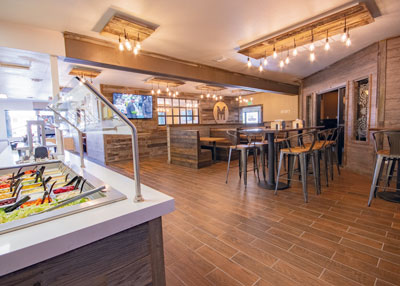 Firing on All Cylinders
Firing on All Cylinders
In normal times, 30% of sales at Mountain Mike’s Pizza comes from dine-in business, but rather than hit the panic button when COVID-19 forced dining rooms to close, the brand doubled down on its established off-premises efforts. “We’ve not only made up that revenue gap — we’ve actually grown on top of that,” says Jim Metevier, president and COO of the 220-unit California-based chain. “Our existing guests shifted to carryout and delivery, and we’ve had a whole bunch of new consumers try our brand. After a couple of weeks of uncertainty, it’s clear that the business model is strong and we’re in a great place. We have the right concept — pizza is largely recession-proof — and we’re continuing to expand at a rate just slightly less than what we would have targeted pre-COVID, mostly because of municipalities shutting down and permitting slowing.”
Metevier anticipates 15 new unit openings this year, compared with 25 to 30 targeted in previous years. Most of the brand’s expansion is with existing franchisees in California, but it’s also striking deals to grow into Nevada and Arizona. Four new units opened this year before COVID-19 hit, and a fifth, with carryout and delivery service only, opened in April. Two new prototype restaurants are opening this summer in Orange County, Calif., and several developments are underway in the San Diego area.
“We have great franchisees, a lot of whom are very passionate and want to continue to build the brand with us,” Metevier notes. “We’re excited about our expansion prospects, and we have some tailwinds now in terms of real estate availability and development costs coming down. And since the pandemic hit, we’ve also seen a big uptick in interest from new franchisee prospects. Everything is firing on all cylinders right now in terms of our brand positioning, our sales momentum and our cost of entry. From a development perspective, it’s kind of a perfect storm.”
GSR Brands Tom & Chee, Gold Star
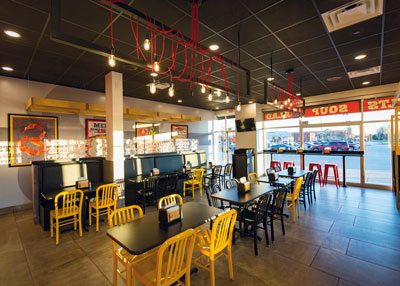 Opportunities Knock
Opportunities Knock
Parent company of Gold Star Chili, a legacy chili and burger brand, and Tom & Chee, a fast-casual grilled cheese, soup and salad brand purchased in 2017, GSR Brands has a dual focus this year: rolling out a new prototype at Gold Star and ramping up franchise growth at Tom & Chee.
“With Gold Star, our focus is much more limited because it’s a very localized brand,” says Samir Daoud, franchise director at GSR, whose father and uncles built the 55-year-old, 75-unit brand. “Our major development move is a remodel initiative, upgrading Gold Star stores to our new Generation 5 prototype. We have a bunch of units that are completed and this year expect to do another 10 to 12.”
Tom & Chee, which GSR scaled back, refined and reintroduced with its own new &Crafted design prototype in 2019, now has 12 units, including one company owned and one licensed. Daoud says a new unit will open in Pennsylvania in the fourth quarter of this year, and existing franchisees are set to expand in Oklahoma City as well.
Interest from potential new franchisees is also rising. Of roughly 70 solid leads in the Tom & Chee pipeline, Daoud says 10 to 15 are far down the qualification pathway toward signing. “I’m really excited about the growth we expect to achieve with that brand,” he says, adding that revenues between the two brands so far this year, despite the pandemic, are above what they were last year.
“It might sound counterintuitive, but there’s a lot to be optimistic about,” Daoud adds. “COVID-19 required us to get better at safety and about our messaging to guests and franchisees around that. It forced us to sharpen our pencils and our operations, becoming a more well-oiled machine. Whenever there are changes and challenges, there almost always comes opportunity. We see strong opportunities to partner with people who may be newly interested in franchising, and we’ll have our ears to the ground for what we think will be new and better real estate opportunities.”
Wayback Burgers
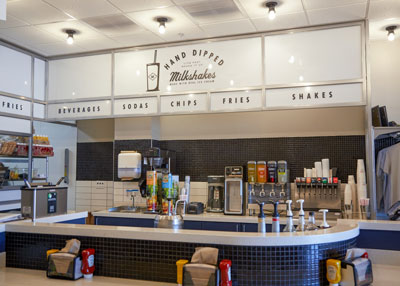 Rebooting Franchise Sales
Rebooting Franchise Sales
Starting out the year with a goal of awarding 15 new domestic and 5 international franchises, Wayback Burgers is confident both goals can be met and that new-unit targets of roughly the same numbers will also be hit, says Patrick Conlin, president of Wayback’s parent company Jake’s Franchising company.
The only snag he sees are delays due to slowdowns in permitting on the part of municipalities, and lease signings on the part of landlords swamped with existing tenant default issues.
Wayback’s newest unit, in Woodbridge, Va., was awaiting final inspections when COVID-19 shutdowns hit. “The Board of Health finally agreed to do a virtual tour of the restaurant in early June,” Conlin says. “That’s the first I’ve heard of a final inspection being done virtually, but it means that franchisee should be open by July.”
A nearly completed unit in Austin, Texas, will also open this summer. It, too, was only awaiting permits for exterior signage and final inspections. And several new franchisee prospects have emerged since Wayback rebooted its franchise sales efforts in May. “We went through our database of prospects from the past few years and sent out an e-mail blast just to check in and invite them to talk about the opportunity that they had inquired about,” Conlin says. “That garnered a lot of feedback and renewed interest among many of those folks, who are now at home, maybe out of a job and/or rethinking their career opportunities.”
With candidates unable to travel to headquarters, Wayback pivoted to virtual Discovery Days. As of early June, four such events had taken place with attendance growing each time, according to Conlin. “It’s exciting to see this new process working,” Conlin says. “We have a large number of inquiries from new prospects who are highly engaged, qualified and out there visiting with existing franchisees.”
As for those existing franchisees, after hitting “rock bottom” in the early days of the pandemic, Conlin says several are now setting sales records despite having closed dining rooms. Several, too, are looking to expand. “We’re very optimistic about that,” he adds. “We foresee opportunities for second-generation spaces at lower rent and in better locations than we were looking at three months ago. Construction costs are also likely to come down, and one of the biggest challenges to expansion, the labor shortage, looks much different now.”
Stoner’s Pizza Joint
 Stoked for Growth
Stoked for Growth
South Florida-based franchisee John Stetson opened his first Stoner’s Pizza Joint unit in the Fort Lauderdale market last November. By mid-March, as pandemic-related closures hit, he had opened two more. “I was just praying that they wouldn’t shut down delivery and carryout, and they didn’t,” Stetson says. “As other restaurants closed, my competition went down significantly, and I saw it as an opportunity to grow, to get aggressive. I signed a three-unit deal to expand in Georgia and expect to open the third of those in July. I also just signed another lease for a fourth Georgia unit that will open later this summer. In April and May, I saw a roughly 20% increase in gross sales.”
A delivery- and takeout-focused concept — pre-pandemic, 20% to 25% of Stetson’s sales came from dine-in business — Stoner’s taps second-gen, in-line locations of 1,000 to 1,500 square feet. It’s a real estate model that Stetson says helps keep development costs and risks low and that has enabled him to expand rapidly. “I don’t want to take on a big construction or development project,” he notes. “Those timelines and budgets are never in line, so I look for preexisting restaurants that have closed.”
Going forward, it’s also a model that Stetson expects to work in his favor for continued expansion. “I’m looking to do more units in South Florida, but I’m waiting patiently to see where the market is headed and who is going to open back up,” he says. “It’s sad, but you just can’t operate at 50% in this business, and a lot of dine-in brands that have tried to pivot to carryout and delivery aren’t making it. I think when the PPP [Paycheck Protection Program] support runs out, there will be a lot of vacancies out there. I’d anticipate some pretty good deals on real estate and leases. It’s been a crazy few months, but I’ve never been more excited to expand.”
Companywide, Charleston, S.C.-based Stoner’s reports it has letters of intent to expand its franchisee footprint into Kentucky and central Florida over the next few months. By year’s end, its total unit count is expected to grow from 13 to 25.
WaBa Grill
 Remaining Nimble, Moving Forward
Remaining Nimble, Moving Forward
“We’ve had some delays but are optimistic about development this year and beyond,” says Mark Finnegan, vice president of Marketing and Technology at WaBa Grill, a 180-unit fast casual serving signature rice bowls and salads. Operating primarily in and around its Los Angeles home base, WaBa has also expanded to the San Diego market and into Arizona. Two new units, one in North Hollywood and one in Colton, Calif., were expected to open by June, and a third, signed by an existing franchisee in May, is opening later this year in South Orange County, Calif.
“We have a lower capital investment than many brands do, so we’re still seeing strong interest from potential new franchisees,” Finnegan says. “But what’s even more exciting is that we’re seeing existing franchisees wanting to add units and/or upgrade their locations. They’re seeing the market dynamics change, with areas that previously were cost-prohibitive now starting to become accessible.”
Finnegan adds that although WaBa experienced temporary revenue declines, sales have rebounded, thanks to its ability to remain nimble and pivot to off-premises only. “One thing we’ve learned is that we’re good at that service model,” he notes. “Fortunately, we made aggressive moves in 2019 to boost third-party delivery and digital ordering capabilities.”
The 14-year-old brand has also used the slowdown to fine-tune a new prototype and gear up for its first broad-based remodel program. “We focused hard on value-engineering the new design and refining our real estate strategy,” Finnegan says. “Our base used to be 1,400 square feet, but with the rapid shift to digital ordering, we now feel comfortable with 1,100 to 1,200 square feet. The new prototype looks great but is also even more cost-efficient for franchisees. We’re really excited about that.”

